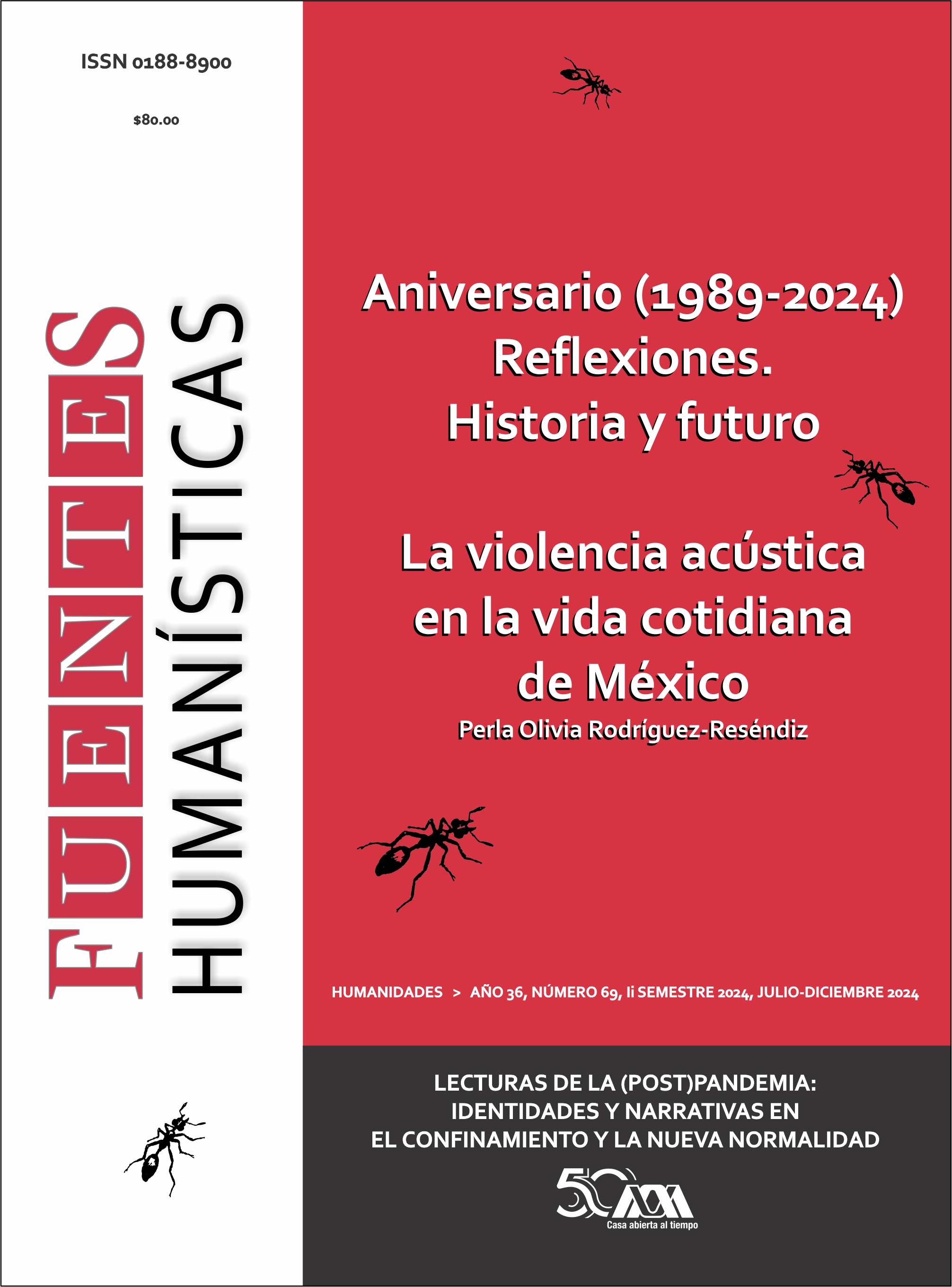Acoustic violence in Mexican daily life
Abstract
We can understand what societies say about themselves by studying the sounds of everyday life. The 21st century, characterised by the abundance and diversity of sound content, is faced with acoustic violence. Debates are underway regarding potential solutions to the various forms of violence that impact society. This article will examine acoustic violence from the perspective of acoustic ecology and sound documentation.Downloads
References
Buch, Camilla. (2024). For your ears only – the rise of social audio. Schibsted Future Report. https://futurereport.schibsted.com/for-your-ears-only-the-rise-of-social-audio/
Cruz, Aaron M. (s. f.). Oda al Autotune: himnos para la generación de cristal. Retina. https://retinatendencias.com/cultura-digital/oda-al-autotune-himnos-para-la-generacion-de-cristal/
Declerq, Brecht. (8 de junio de 2024). International Federation of Television Archives. Neck Deep in Digital Oil? Public Broadcaster’s Archives as Artificial Intelligence Training Datasets. Documentary Heritage News 17(41). https://documentary-heritage-news.com/2024/06/vol-17-no-41/
De Gortari Ludlow, Jimena. (2013). Guía sonora para una ciudad. Universidad Autónoma Metropolitana, Unidad Cuajimalpa.
Domínguez Ruiz, Ana Lidia M. (2013). Violencia acústica y cuerpo social: el ruido de las ciudades latinoamericanas. En Acta científica XXIX Congreso dela Asociación Latinoamericana de So
ciología (alas). http://actacientifica.servicioit.cl/biblioteca/gt/GT25/ GT25_DiazHerrera.pdf
Gallón, Angélica. (12 de junio de 2024). ¿Para qué sirve un cuarto de silencio en una cárcel de mujeres de México? El País. https://elpais.com/america-futura/2024-06-13/para-que-sirve-u
n-cuarto-de-silencio-en-una-carcel-de-mujeres-de-mexico.html
Garrini, Daniela y Leonardini, Rubén. (2010). Contaminación Acústica. Como agente generador de disfonía profesional en la actividad docente. Grupo Sanco Seguros. FISO.
Gonzalo, Marilín. (14 de abril de 2021). El auge del audio social. Newtral. https://www.newtral.es/auge-audio-social-clubhouse/20210414/
Instituto Nacional de Estadística, Geografía e Informática (INEGI). (2024). Encuesta Nacional de Seguridad Pública Urbana (ENSU). Primer trimestre de 2024. INEGI. https://www.inegi.org.mx/programas/ensu/
Krug, Etienne G., Mercy, James A., Dahlberg, Linda L. y Zwi, Anthony. B. (2002). The world report on violence and health. The Lancet, 360(9339). https://doi.org/10.1016/S0140-6736(02)11133-0
Linde, Pablo. (7 de enero de 2020). La contaminación sonora también mata. El País. https://elpais.com/sociedad/2020/01/02/actualidad/1577981747_643301.html?event_log=regonetap
Mouzo, Jessica. (15 de noviembre de 2022). Más de mil millones de jóvenes pueden estar en riesgo de sordera por usar cascos a todo volumen o ir a lugares de ocio con música alta. El
País. https://elpais.com/salud-y-bienestar/2022-11-15/mas-de-mil-millones-de-jovenes-pueden-estar-en-riesgo-de-sordera-por-usar-cascos-a -todo-volumen-o-ir-a-lugares-de-ocio-con-musica-alta.html
Organización Mundial de la Salud (OMS). (2 de marzo de 2022). La OMS publica una nueva norma para hacer frente a la creciente amenaza de la pérdida de audición. Noticias OPS. Organización Panamericana de la Salud / Organizacón Mundial de la Salud Región de las Américas (OPS/OMS). https://www.paho.org/es/noticias/2-3-2022-oms-publica-nueva-norma-para-hacer-frente-creciente-amenaza-perdida-audicion
Organización Panamericana de la Salud (OPS) y Organización Mundial de la Salud (OMS). (2021). Informe mundial sobre la audición. Organización Panamericana de la Salud; 2021. https://doi.org/10.37774/9789275324677.
Paul, Carlos. (13 de agosto de 2010). Denuncian el uso de sonidos como arma de control y represión social. La Jornada. https://www.jornada.com.mx/2010/08/13/cultura/a03n1cul
Podimo. (2024, 13 de marzo). Espacio de oportunidad Audio-culturas. Una mirada al presente y futuro del pódcast. [Blog]. https://podimo.com/es/blog/espacios-de-oportunidad-audio-culturas
Primer mapa de la industria del audio en español: 400 entidades dinamizan la creciente industria del audio. (23 de marzo de 2023). Dosdoce.com. https://ww.dosdoce.com/2023/03/23/primer-mapa-de-la-industria-del-audio-en-espanol400-entidades-dinamizan-la-creciente-industria-del-audio/
Rodríguez Manzo, Fausto y Garay, Elisa. (2012). El mapa de ruido de la ciudad de México. En Seminario [de] Urbanismo Internacional (8º : 16 al 20 de abril, 2012 : Ciudad de México). Lugares y visiones urbanísticas en la ciudad contemporánea. https://zaloamati.azc.uam.mx/items/fa8ae8a0-e811-4602-b8cc-3d5681165ed1
Rodríguez-Reséndiz, P. O. (2017). El ruido y la violencia acústica en la escuela: sonidos en el aula. Propuesta para la prevención social de la violencia en la educación inicial en México. Ixaya. Revista Universitaria de Desarrollo Social, (9), 51-74. http://revistaixaya.cucsh.udg.mx/index.php/ixa/article/view/6777
Rodríguez-Reséndiz, P. O. (2020). El archivo digital sonoro. UNAM, Instituto de Investigaciones Bibliotecológicas y de la Información.
Ruiz, Soledad. (2023). El odio a la música. Spectrum. Ensayos sobre el sonido y la escucha. [Podcast]. Pandemia Teatro. https://www.pandemiateatro.es/spectrum-el-odio-a-la-musica/
Schafer, Raymond Murray. (1977). Our Sonic Enviroment and The Soundscape the Tunning of the World. Destiny Books.
Schafer, Raymond Murray. (2006). Hacia una educación sonora. Radio Educación, Conaculta.
Westerkamp, Hildegard. (1974). Soundwalking. Sound Heritage, 3(4), 18-27.
Wrightson, Kendall. (2004). Una introducción a la ecología acústica. Estudio de Música Electroacústica (EME). http://www.eumus.edu.uy/eme/ps/txt/wrightson.html
Truax, Barry. (2001). Acoustic communication. Ablex Publishing Corporation.

This work is licensed under a Creative Commons Attribution-NonCommercial-ShareAlike 4.0 International License.
Authors who publish in this journal accept the following conditions:
Fuentes Humanísticas is licensed under a Creative Commons Attribution-NonCommercial-ShareAlike 4.0 International (CC BY-NC-SA 4.0) license.
Authors retain copyright and grant the journal the right of first publication, with the work licensed under the Creative Commons Attribution license CC BY-NC-SA 4.0, which allows third parties to:
Share — copy and redistribute the material in any medium or format.
Adapt — remix, transform, and build upon the material.
The licensor cannot revoke these freedoms as long as you follow the license terms.
Under the following terms:
Attribution — You must give appropriate credit, provide a link to the license, and indicate if changes were made. You may do so in any reasonable manner, but not in any way that suggests the licensor endorses you or your use.
NonCommercial — You may not use the material for commercial purposes.
ShareAlike — If you remix, transform, or build upon the material, you must distribute your contribution under the same license as the original.
No additional restrictions — You may not apply legal terms or technological measures that legally restrict others from doing anything the license permits.
Authors may enter into other independent and additional agreements for the non-exclusive distribution of the published version of the article in this journal (e.g., placing it in an institutional repository) as long as they clearly indicate that the work was first published in this journal.










